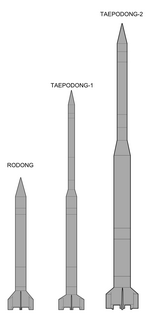Taepodong-1
| Taepodong-1 | ||
|---|---|---|
 Misiles Rodong y Taepodong 1 y 2 | ||
| Tipo | vehículo espacial | |
| Historia de producción | ||
| Fabricante |
| |
| Especificaciones | ||
| Peso | 33,4 ton | |
| Longitud | 25,8 m | |
| Diámetro | 1,8 m | |
| Alcance efectivo | 2500 km | |
| Motor | combustible líquido | |
| Sistema de guía | Inercial. | |
El Taepodong-1 es un misil de tres etapas, balístico y de medio alcance desarrollado por Corea del Norte y actualmente en servicio. Este misil está basado en el Scud y puede utilizarse como un arma ofensiva con ojiva nuclear, o bien como vehículo de lanzamiento espacial.
Historia
[editar]El 31 de agosto de 1998, los norcoreanos anunciaron que habían usado su Taepodong-1 para lanzar su primer satélite artificial, el Kwangmyŏngsŏng, desde una lanzadera en la península de Musudan-ri. Sin embargo, las fuentes occidentales nunca encontraron el presunto satélite en órbita. Se cree que la tercera etapa de vuelo falló y el satélite cayó a gran velocidad.
Durante el lanzamiento del Kwangmyŏngsŏng se registró la siguiente secuencia. La primera etapa propulsa al cohete durante 95 segundos y posteriormente de desprende, cayendo sobre el Mar de Japón en 40°51′N 139°40′E / 40.850, 139.667. La segunda etapa hace lo mismo durante 144 segundos y aterriza sobre el Océano Pacífico en 40°13′N 149°07′E / 40.217, 149.117. La tercera etapa funcionó durante 27 segundos. De acuerdo con los medios norcoreanos, el satélite estaba en órbita 5 minutos después del lanzamiento.[1]
Descripción
[editar]- Fuerza: 525.25 kN
- Masa: 33 406 kg
- Diámetro: 1.80 m
- Longitud: 25.80 m
La primera etapa del cohete es un Nodong-1 IRBM.
Referencias
[editar]- ↑ Broadcast excerpted in «Kwangmyongsong». Encylopedia Astronautica. Archivado desde el original el 22 de abril de 2006. Consultado el 8 de abril de 2006.
Véase también
[editar]Enlaces externos
[editar]Text is available under the CC BY-SA 4.0 license; additional terms may apply.
Images, videos and audio are available under their respective licenses.
